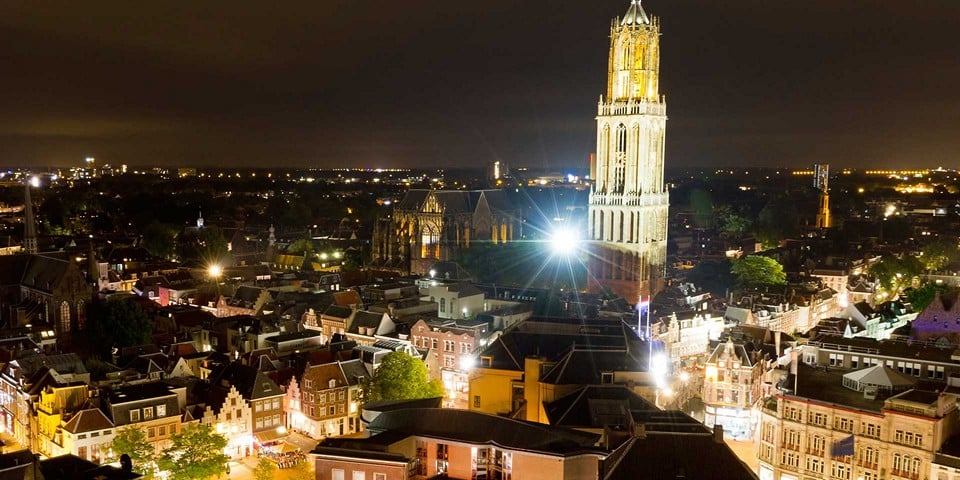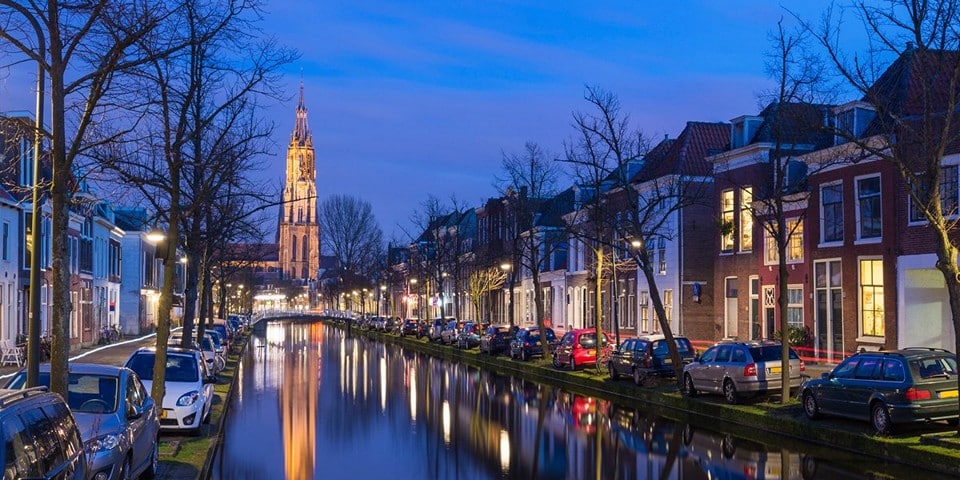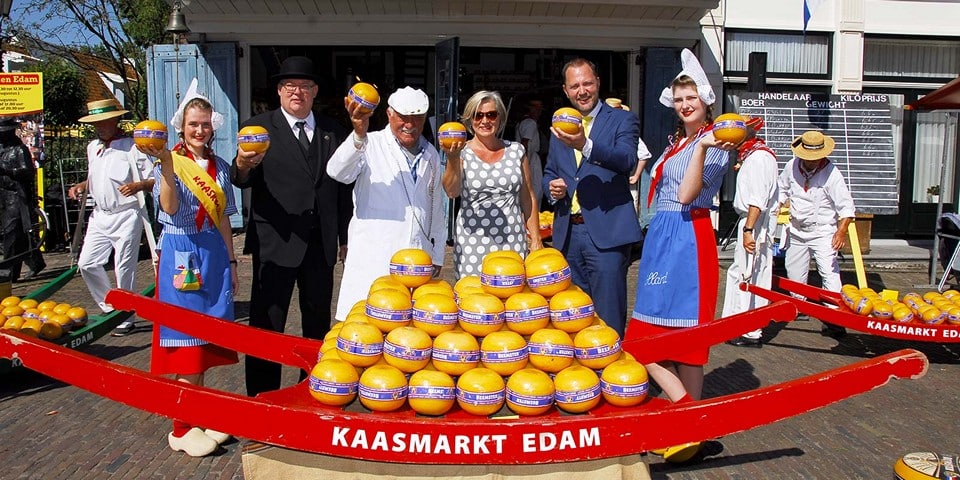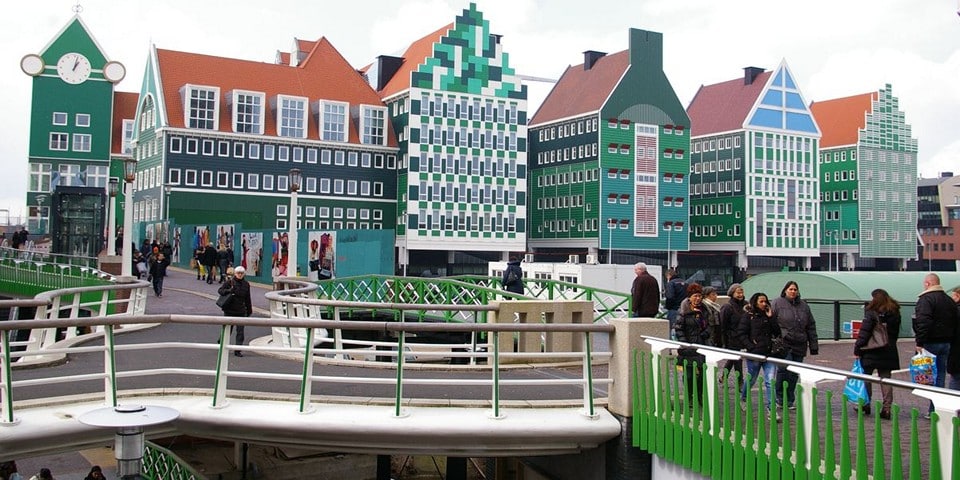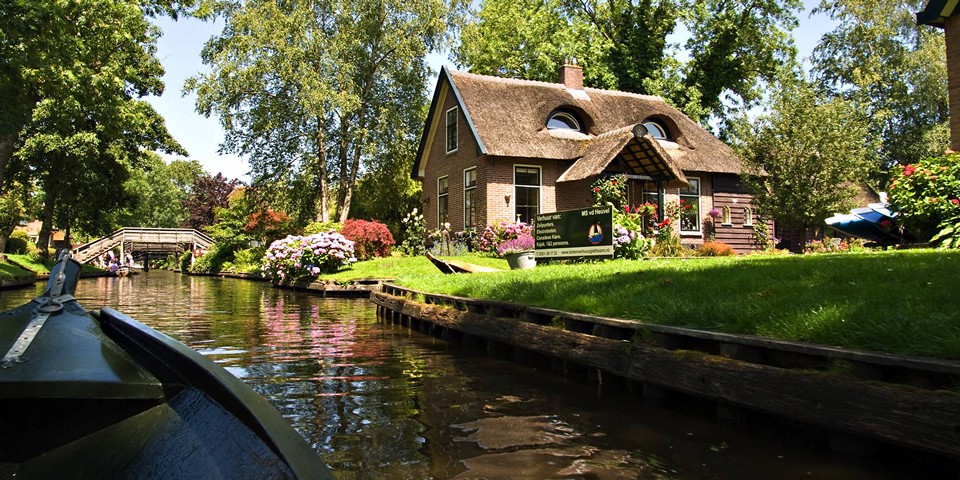Gouda is famous for its cheese. The product produced here is the embodiment of practicality, for which the Dutch appreciate it: thanks to its hardness and high weight (from 5 to 12 kg), Gouda is easy to store, transport and even use as a means of payment. So, at least, Dutch sailors once did, paying port duties with cheese. But cheese products are not the only attraction of Gouda. It is worth coming here if only to see the local town hall, the longest church in the country, magnificent houses and castles.
Geography
Gouda is located in the province of South Holland (Zuid-Holland) at the intersection of three major cities. Rotterdam (Rotterdam) is located from Gouda at a distance of 18 km to the south-west, Hague (Den Haag) - 29 km northwest, Utrecht (Utrecht) - 29 km to the north-east. Amsterdam, the capital of the country, lies in the northeast direction. It separates it from Gouda 77 km along the highway, 41 km in a straight line.
Gouda's area is 18.1 km2, and more than 70 thousand people live here. 25% of the population are migrants or their descendants, with 10 % of their number being Moroccans. Thanks to them, the birth rate in the city significantly exceeds the death rate. More than 25% residents are under 19 years old, 20% are in the 50-64 age group, 15 % are older.
Two rivers flow through Gouda. Hollandse IJssel flows in the southern part and goes along the outskirts, first in a northern direction, then to the south, after which it leaves Gouda. Thus, the river is the southern border of Gouda. At the point where Hollandse IJssel enters the city, two canals Voorhaven and Stroomkanaal branch off to the northwest of the river. Then they both cross the Gouwekanaal, which goes further north, and when leaving Gouda, it transforms into the Gouwe River.
Several large bodies of water are located on the border with the northeastern part of the city. Lake Elfhoeven adjoins Gouda, where anyone can practice sailing.
Most of the city lies on soft peaty soil, making the land unstable. To avoid constant flooding, a large number of canals were dug in Gouda. In addition, the city spends huge amounts of money every year to prevent buildings from settling.
History
A peat-mining settlement near the Gouwe River was first mentioned in documents in 1139. The village got its name from the name of the river. One of the versions of the origin of the word "Gouda" is the transformation of the German "gulda", which means "gold", and "ahwõ", which can be interpreted as "natural flow in the area of clay." It is possible that the word "gold" is explained by burning peat.
Thanks to the canals laid through the village, the locals carried on lively trade with other cities in the Netherlands, which contributed to its prosperity - and already in 1272 Count Floris V (Floris V) granted Gauda city rights. After some time, the city was surrounded by fortress walls, and in the XIV century. on the outskirts, the Gouda castle (Kasteel van Gouda) was built, whose task was to protect the port. Now only the foundation and underground passages are left of it, some of which lead through canals. The castle was destroyed in 1577, according to one version - so as not to fall into the hands of the Spaniards, according to the other - the locals got rid of the fort, rebelling against the ruler.
Gouda burned to the ground several times, and periods of economic growth alternated with severe economic decline.
In 1673, a plague appeared in the city, destroying the 20% population (3 thousand people). In the XIX century. the fortress walls were dismantled, and the economy stabilized thanks to the development of industry and the railway, which was located on the route between Rotterdam and Utrecht, and after a while connected Gouda with The Hague.
During World War II, Gouda suffered from Allied bombing. After the war, the city began to expand - and now its area has tripled. Many canals were closed to navigation, but under the influence of the public, some reservoirs were opened. First of all, these are the canals along which the Hollandse IJssel and Gouwe rivers flow.
Attractions
In Gouda there are 355 monuments of national importance and a huge number of municipal monuments. These are houses, temples, industrial enterprises of the 16th-20th centuries. The most famous of them are the old town hall, the weighing chamber, the church of St. John and the Gauve Church. Also, be sure to visit the main museum of the city, Museum Gouda, and in the summer - the local cheese market, which is open during the warm season on Thursdays.
Town hall
City Hall of Gouda (Het Oude Stadhuys Gouda) - one of the oldest town halls in the Netherlandsbuilt in the Gothic style. To an uninitiated person who faces her, she may well remind the church.
The decision to build a new mayor's office to replace the old townspeople was made in 1365. But due to financial problems, construction was constantly postponed, and therefore the construction of the landmark began only in 1448, finishing eleven years later. The building material was Belgian limestone, and to prevent the building from sinking under the marshy soil, the foundation was reinforced with heavy oak beams. Until the 17th century. the mayor's office was surrounded by a moat filled with water, so it was possible to get into it only by a drawbridge.
The town hall was redesigned more than once, supplementing with new elements. In the XVI century. an elegant porch appeared, in the middle of the XX century. statues of the rulers of Holland were installed on the facade. On the first tier, you can see the dukes of Burgundy who once ruled Holland - Karl the Bold (Karel de Stoute), his daughter Maria (Maria van Bourgondië) and the grandson of Philip I the Handsome (Felipe I de Habsburgo el Hermoso). Above them are sculptures of the Count of Holland Floris V and the Mock Bavarian (Jacoba van Beieren).
In the 60s. XX Art. a clock appeared on the town hall, under which, once an hour, you can see a puppet show telling how Floris V is driving from the castle to give Gauda city rights. The interior of the City Hall dates back to the 17th-18th centuries. There are many tapestries, portraits, sculptures here.
Nowadays, weddings, conferences and other events take place in the old town hall. The entrance for ordinary visitors is usually closed, but sometimes an open door is organized here. And then everyone can see the old city hall from the inside.
- Address: Markt, 1 (Market Square)
- Website: stadhuysgouda.nl
Church of st. John the Baptist
Church of St. John the Baptist (Sint Janskerk) is the longest church in the Netherlands, with a length of 123 m, a width of 49 m, and a total area of 4815 m2. The modern building appeared in the 15th century. after the fire, which destroyed the chapel located here, which was located in the territory of the old cemetery. The new temple was expanded several times, and by 1485 it was the longest religious building in the country.
The temple is famous for its stained glass windows, very unusual and beautiful as for a Protestant temple. Some of them appeared in the 16th century. and were able to survive in the era of iconoclasm, as well as during the Second World War (they were taken to a safe place). The stories depicted on the stained-glass windows tell both biblical parables and the life of Holland. One of them was created in memory of the liberation from the Nazis. In total, the temple has 72 stained glass windows of various sizes.
Inside the church there are several ancient chapels and a crypt in which eminent townspeople were buried, as evidenced by the tombstones on the floor. The last burial took place here in 1832. In 1676, a carillon of 33 bells was installed on the bell tower of the tower; now there are fifty of them.
In the church of St. John the Baptist still holds services - usually on holidays and Sundays. Also, various exhibitions are held here, they give concerts, the schedule of which can be found on the website, you can regularly listen to the organ.
- Address: Achter de Kerk, 16 (150 m from Market Square);
- Web site: www.sintjan.com;
- Ticket: adults - 6 €, 12-17 years old + students - 3 €;
- Opening hours: from November 1 to March 1 - from 10 to 16, from March 1 to November 1 - from 9 to 17.30. The temple is closed for Christmas, New Year, on Sunday you can only go to church services.
Gauve Church
The Gouwe Church (Gouwekerk) is the tallest structure in the city, which, together with the spire, is 80 meters high. It was built of red brick, decorated with several sculptures, under the roof you can see an openwork ornament.
The temple appeared at the beginning of the XX century. on the site of the Catholic Church of St. Joseph. In the sixties of the last century, the Franciscans left the church, handing it over to the parish of the Assumption of the Virgin. But ten years later, the church council decided to sell the building, since there was no money for its maintenance. In 1979, the new owner of the church was the Johan Maasbach Wereldzending (Protestant Pentecostal movement).
Today, services are being held in the temple. For tourists, the church is usually closed, so you can only get here for servicesheld on Wednesdays and Sundays. But sometimes an open day is held here, and then you can climb the tower.
In 2016, the temple was bought by an as yet unknown buyer who wants to open a conference hall and a 40-room hotel here.
- Address: Hoge Gouwe, 39;
- Web site: www.maasbach.nl;
- Services: Sunday from 10.30. until 12.00, on Wednesday from 20 to 21.
Weighing Chamber
The Weighing House (De Waag or Weighing House) is located on the Market Square, and its windows overlook the back side of the town hall. This is an original two-storey building, the facade of which is decorated with a bas-relief, where you can see how the cunning employee of the Weighing Chamber holds the scales with his foot while weighing.
The Weighing Chamber was built in 1668, and initially its first floor was intended for weighing cheesethat was brought for sale by cheese makers who paid taxes here. Currently, anyone can get here, buy gouda and souvenirs.
On the second floor there was an arsenal, which remained here until 1907. Now there is a museum of cheese and traditional crafts, information is provided in English and Dutch.
In summer, on Thursdays, in the morning between the Weight Chamber and the Town Hall, there is a cheese market where you can buy a gouda. During the purchase, you need to pay attention to the stamp: rectangular indicates that the buyer has farm cheese, round - factory cheese.
- Address: Markt 35/36 (300 m from Market Square);
- Web site: www.goudsewaag.nl;
- The museum is open: from April to October - from 10 am to 4 pm;
- Tickets: adults - 4.5 €, up to 12 years old and after 65 - 4.25 €, family ticket (2 adults + 2 children) - 12.5 €. In combination with a visit to the museum, there is the possibility of a cheese tasting for 1 €.
Gouda Museum
In the Museum Gouda, you can see canvases by artists of the 18th-19th centuries, sculptures, a collection of altars and objects of church art. It is interesting to look at an old pharmacy, a dental office a century ago. In the basement of the museum, they are housed in rooms where mental patients were kept, torture chambers. Here you can also learn a lot about the history of beer, cheese, pipes and ceramics that contributed to the city's prosperity.
The museum was founded in 1874 and was originally located on the Market Square. In 1947, the exposition moved to the Catharina Gasthuis hospital, which explains the presence of a medieval pharmacy here, rooms for doctors and patients.
- Address: Achter de Kerk, 14 (near the Church of St. John the Baptist);
- Web site: www.museumgouda.nl;
- Working hours: Tuesday-Saturday - from 10 to 17, Sunday - from 11 to 17;
- Tickets: adults 9 €, from 5 to 17 years old - 3 €, up to 4 years old free.
How to get from Amsterdam
The distance from Amsterdam to Gouda along the highway is about 70 km, so the road will take an hour and a half. The most convenient way to get there is by train or car.
By train
Trains from Amsterdam to Gouda leave from Amsterdam Centraal station every ten to twenty minutes from 4 am to 1 am. The journey takes 55 minutes. A ticket in the first class costs 19.2 €, in the second - 11.3 €. More details about the schedule, route and price can be found here: www.ns.nl/en.
By car
The shortest road route from the capital of Holland to Gouda takes 76 km, and therefore can be reached in an hour and a half. To do this, you need to leave Amsterdam on the A2 highway, and go to the A12 highway, bypassing Utrecht. Then follow the A12 / E25 / E30 towards Goudse Poort / N452 (Waddinxveen). Then you need to move towards Nieuwe Gouwe OZ, turn onto Industriestraat, go along Kon. Wilhelminaweg, Rotterdamseweg and Schielands Hoge Zeedijk towards Naaierstraat (Gouda).
Why come here
The sights of Gouda are a must see for anyone who wants to know where the best cheeses in the Netherlands are made.
In addition, the city is famous for making candles, waffles, ceramics, and smoking pipes. And also the festival of light Gouda bij Kaarslicht, which takes place before Christmas. In the evening, thousands of candles light up on the old town hall and other city buildings, and music and Christmas songs take everyone into a fairy tale.










